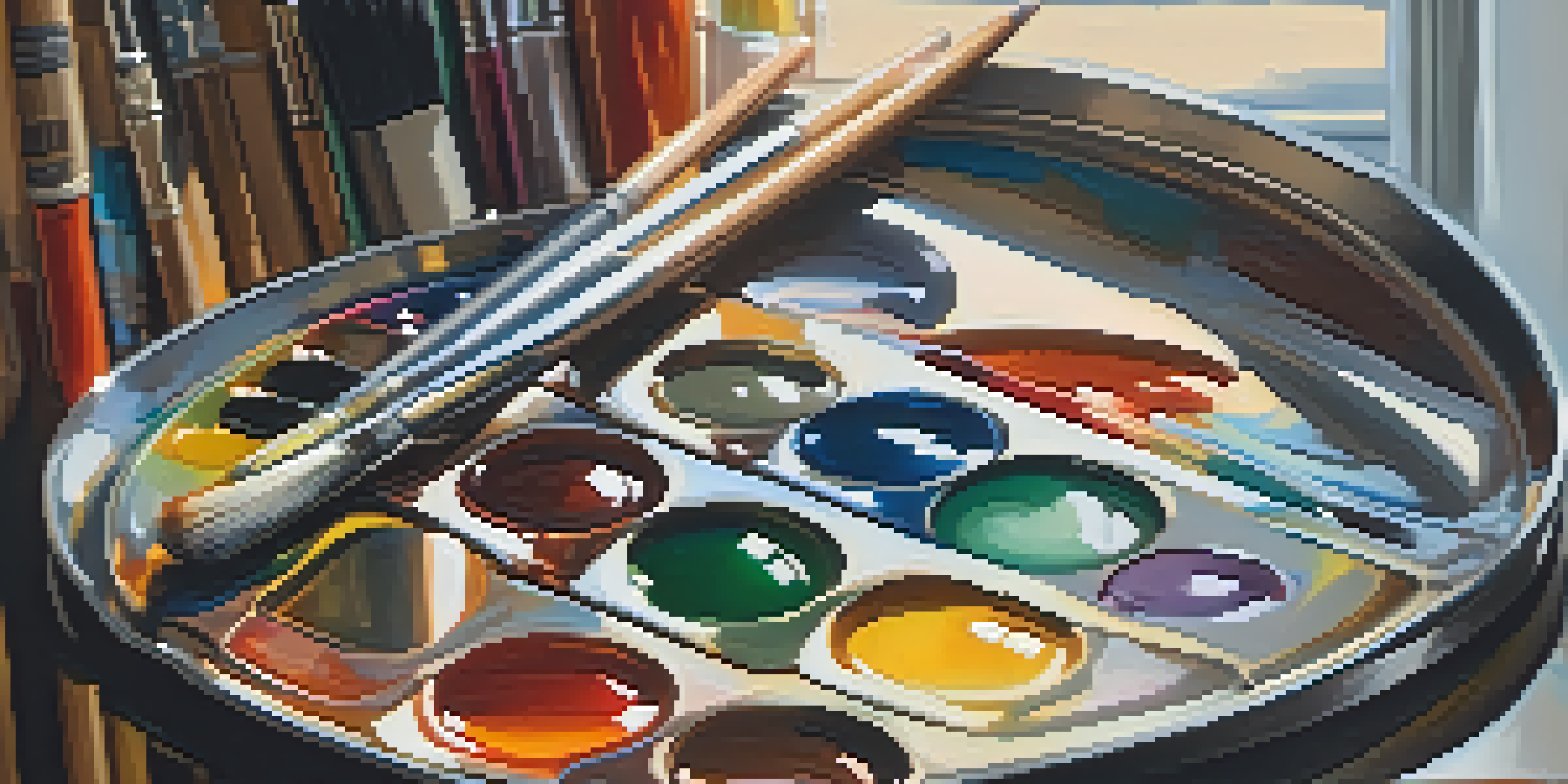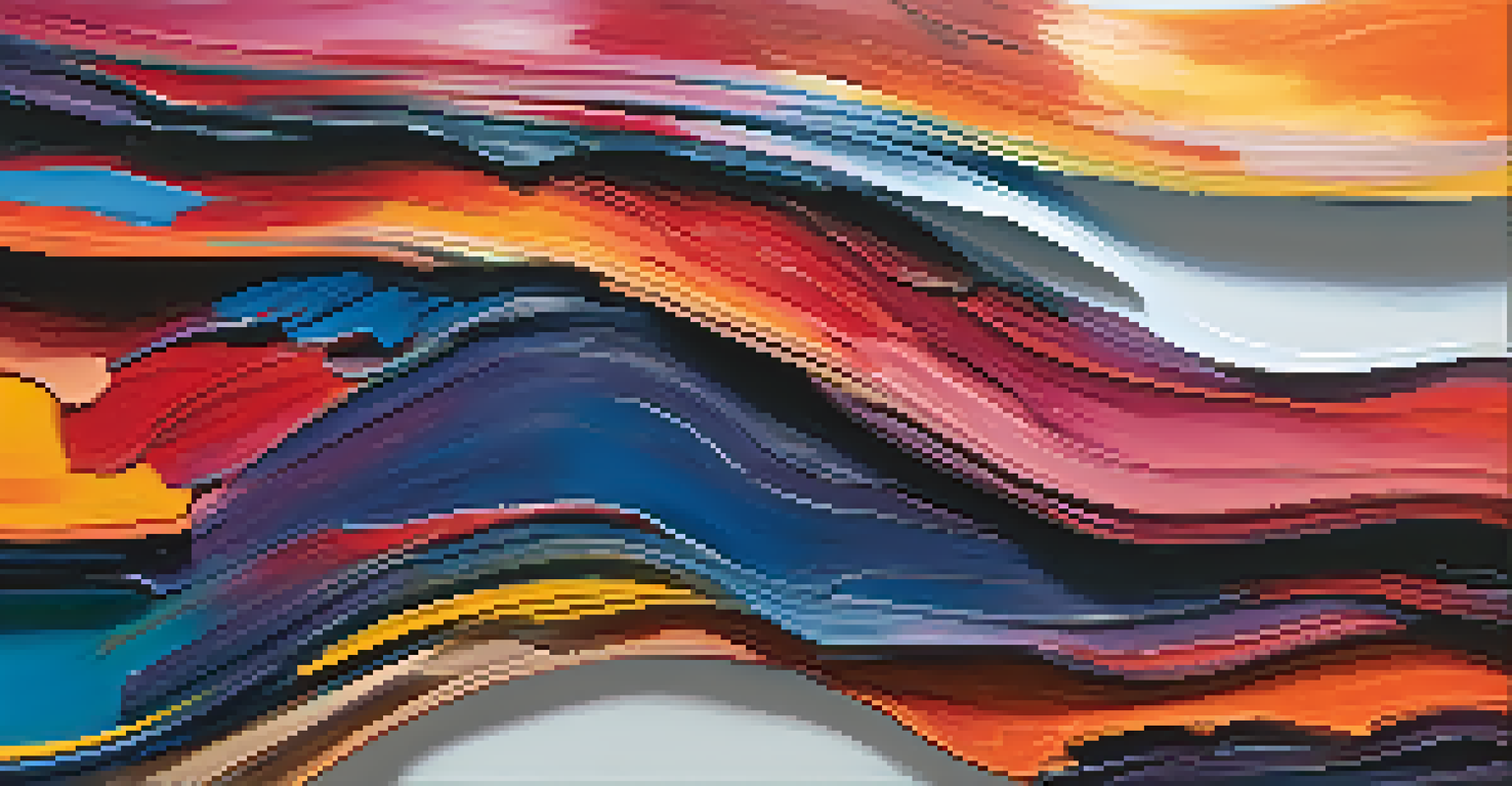The Role of Brushstrokes in Conveying Emotional Depth

Understanding Brushstrokes: The Basics of Expression
Brushstrokes are the marks made on canvas by an artist's brush, and they vary greatly in technique and style. Each stroke can evoke different feelings, shaping the viewer's perception of the work. Just as a writer chooses words to convey emotion, artists select brushstrokes to express their inner thoughts and feelings.
Art is not freedom from discipline, but disciplined freedom.
For instance, gentle, sweeping strokes might convey serenity, while sharp, jagged strokes can signify chaos or anger. Think of a calm lake versus a stormy sea; the brushwork can create a similar contrast in emotional tone. Understanding the basics of brushstrokes allows us to appreciate the deeper meanings behind a painting.
As we delve deeper into the world of art, we begin to see how these seemingly simple gestures can communicate complex emotions. This understanding is not just for artists but also for viewers who wish to connect more profoundly with the artwork.
The Emotional Language of Different Brushstroke Techniques
Every brushstroke technique carries its own emotional weight. For example, a thin, delicate line can evoke vulnerability, while bold, thick strokes may suggest strength and confidence. Artists often use these varied techniques intentionally to guide the viewer’s emotional response.

Consider Van Gogh’s impasto technique, where thick layers of paint create texture and movement, drawing the viewer into the emotional turmoil he experienced. His swirling skies and expressive landscapes resonate with feelings of passion and intensity. This is a perfect example of how brushstrokes can become a visual language of emotion.
Brushstrokes Convey Emotions
Different brushstroke techniques evoke a range of emotions, allowing artists to communicate their inner feelings through their work.
By recognizing these techniques, we can decode the emotional narratives embedded in artworks. It’s like learning to read between the lines of a story; once you understand the subtleties, the emotional depth becomes even more profound.
How Color and Brushstrokes Work Together
Color and brushstrokes are like dance partners in the world of art, each enhancing the other's ability to convey emotion. A vibrant red applied with energetic strokes can evoke feelings of passion or anger, while soft blues with gentle strokes might create a sense of calm. The interplay between color and brushwork can amplify the emotional experience of a piece.
Every artist dips his brush in his own soul, and paints his own nature into his pictures.
For instance, Claude Monet often used soft brushstrokes combined with pastel colors to evoke tranquil scenes filled with light and air. This combination invites the viewer to feel a sense of peace and beauty. The emotional depth of his work stems not just from color choices but from the way those colors are applied.
Understanding this relationship is crucial for both artists and art appreciators. It illustrates how the aesthetics of color and technique can come together to create a rich emotional tapestry.
The Role of Texture in Emotional Expression
Texture, created by the way brushstrokes are applied, adds another layer of emotional complexity to a painting. A rough texture can evoke feelings of discomfort or turmoil, while smooth surfaces may convey tranquility or harmony. Artists often manipulate texture intentionally to enhance the emotional narrative.
For example, the textured surfaces in the works of Jackson Pollock can evoke feelings of chaos and spontaneity, mirroring the emotional intensity of his life. Each drip and splash of paint adds to the viewer’s visceral experience, making the emotions palpable. This demonstrates how texture, coupled with brushstrokes, can significantly impact emotional depth.
Color and Texture Enhance Impact
The interplay of color and texture with brushstrokes creates a richer emotional experience, amplifying the artwork's overall message.
As we explore texture in art, we realize it adds a three-dimensional quality to emotional expression. This understanding allows us to engage with artworks on a more profound level.
Cultural Influences on Brushstroke Interpretation
Cultural backgrounds can significantly shape how brushstrokes are perceived and interpreted. Different cultures have unique artistic traditions, leading to various emotional expressions through brushwork. For instance, traditional Japanese ink painting emphasizes simplicity and subtlety, often conveying profound emotions through minimalistic strokes.
In contrast, Western art movements like Expressionism prioritize boldness and intensity, reflecting deeper emotional struggles. This cultural lens can alter how we respond to specific brushstroke techniques. Understanding these influences can enhance our appreciation of international artworks.
By exploring the cultural contexts behind brushstrokes, we gain insight into the diverse emotional landscapes artists navigate. It reminds us that art is not just personal but also deeply connected to collective experiences.
Case Studies: Iconic Works and Their Brushstroke Techniques
Examining iconic works of art allows us to see brushstrokes in action and understand their emotional impact. Take Edvard Munch's 'The Scream'; the swirling brushstrokes create a sense of anxiety and urgency that resonates with viewers. The way Munch applied paint mirrors the chaos and distress of the subject matter, making the emotion felt rather than just seen.
Similarly, in Gustav Klimt's 'The Kiss', the intricate, gilded brushwork conveys intimacy and tenderness. Each stroke enhances the emotional connection between the figures, highlighting love and passion. These case studies illustrate how brushstrokes are not merely technical choices but vital elements of storytelling in art.
Cultural Context Shapes Interpretation
Understanding the cultural influences on brushstroke techniques enhances our appreciation of how emotions are expressed in diverse artistic traditions.
By analyzing these iconic works, we can better appreciate how brushstrokes serve as emotional conduits, inviting us into the artists' worlds and experiences.
The Viewer’s Role in Interpreting Brushstrokes
The relationship between painter and viewer is crucial in interpreting brushstrokes and the emotions they convey. Each viewer brings their own experiences and emotions to the artwork, influencing how they perceive the brushwork. This subjectivity means that one person may feel joy from a vibrant, sweeping stroke, while another might sense sadness.
Art is a dialogue, and brushstrokes are part of that conversation. Their emotional depth becomes even more pronounced when viewers engage with the artwork, reflecting on their feelings and thoughts. It’s like listening to music; the same song can evoke different emotions from different people, depending on their personal experiences.

By recognizing our role in this interpretive process, we can deepen our connection to art. It encourages us to explore not just what we see but what we feel, making the experience of viewing art even richer.